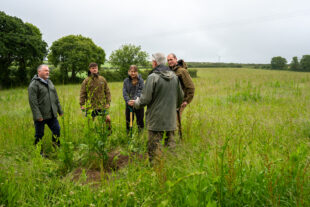https://defrafarming.blog.gov.uk/use-whole-crop-cereal/
Use whole crop cereal
The guidance on this page is for SFI pilot participants only. Please visit GOV.UK for the official Sustainable Farming Incentive scheme guidance.
Find out how land managers can use whole crop cereal as a forage alternative to maize, root crops and other crops prone to erosion.
If you’re completing this action as part of the Sustainable Farming Incentive pilot, how you do it is up to you.
The advice on this page can help you get better environmental and business benefits, but you do not have to follow it to get paid.
About whole crop cereal
You can harvest cereals as a whole crop (grain and stem) and ferment as silage. This silage can then be home-grown feed for livestock.
You can use whole crop cereal as an alternative to maize. It’s an ideal crop on sloping land at risk of erosion and runoff.
Whole crop cereal is harvested earlier than maize, when ground conditions are more likely to be suitable. Harvesting when soil is very wet causes soil damage, erosion and runoff.
An earlier harvest of whole crop allows time to establish a new crop in the late summer or early autumn.
Benefits of whole crop cereal
Your farm business can benefit from:
- a large amount of cost-effective silage
- less silage effluent than maize
- using existing equipment and silage stores
You can use whole crop cereal to reduce runoff and soil erosion, so that:
- fields do not lose fertile topsoil and nutrients, like nitrogen and phosphorus
- water is cleaner, as less soil, pesticides and nutrients reach water bodies
- flood risk is lower, as the flow of water into water bodies is slowed
- there’s more water available for crops, as it infiltrates the soil more easily
- ground conditions are better, so farm operations are possible for longer
How to sow whole crop cereals
You can sow in spring or autumn.
You must follow the farming rules for water. These require you to take steps to stop manure, fertiliser or soil affecting water bodies.
Choosing a location
Use whole crop cereal in place of maize, as part of the crop rotation. Avoid areas known to support rare arable plants.
You should:
- remove compaction before sowing
- sow and create tramlines that run across slopes
What to sow
These cereal crops can be sown as single crops or mixes:
- barley
- oats
- rye
- triticale
- wheat
Consider including legumes to increase benefits for foraging insects and improve protein levels in your silage. Legumes include:
- peas
- lupins
- vetch in mixes with your chosen cereal crop
Sowing whole crop cereals
If your land is known to support late nesting birds like corn bunting and yellowhammer, you can delay sowing until May for a later harvest in August.
Undersowing
You can undersow whole crop cereal with a herbal ley. This establishes early ground cover within the crop and reduces the risk of soil erosion and runoff. The ley can be:
- grass
- legumes
- herbs
- a mix
Undersowing provides green cover after harvest and throughout winter. After harvesting, you can use undersown grass and herbal leys for grazing or late cut silage.
The undersown crop provides low growing cover that helps limit weeds and build soil fertility. Legumes and herbs provide pollen and nectar for foraging insects. The insects provide food for chicks.
Ideally, sow the undersown crop with the whole crop in spring using a slightly reduced seed rate. Scatter or shallow drill the undersown seeds and roll the soil. Both crops can be drilled on the same day, but not in the same pass.
Protect crops during the growing season
Pesticides
Whole crop cereal does not have to be completely weed-free. Low levels of weeds can provide additional pollen and nectar for insects in summer.
If a high weed burden risks damage to your whole crop cereal, consider weed control (chemical and non-chemical).
Do not use contact-acting insecticides between March and harvest, to avoid killing beneficial insects.
How to harvest
You must harvest the crop as whole crop cereal, not as mature grain.
Birds, nests and eggs are protected by law. You must check the field before you cut. If you see signs of nesting birds, delay cutting until birds fledge.
How you’ll know if you’ve been successful
Whole crop cereal will help your soil. It will:
- cause less damage through compaction when compared to maize
- create a better soil structure
- reduce the risk of soil erosion
Whole crop cereal will benefit livestock. It will:
- provide a high energy crop for feeding
- allow the tailoring of whole crop mixes to suit feed requirements
- save costs with home-grown feed
Whole crop cereal can improve water quality. It will:
- reduce the risk of water runoff and flooding
- reduce risk to waterbodies from pollutant runoff
- increase freshwater wildlife, like insect larvae and fish



